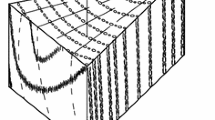Abstract
From load-unloading cycles applied on wood notched specimens subjected to three-point bending, we show that the concept of ‘equivalent LEFM’, usually used for the quasibrittle materials, can be successfully applied to the fracture behavior of wood in mode I. Within this equivalent linear elastic framework, the quasibrittle fracture behavior of wood leads to an R-curve which is evaluated and discussed. On the other hand, the estimate of the peak load (or maximum load) of a structure as a function of the corresponding R-curve is an important problem for a building material such as wood. After a review of some general results about the connection between the R-curve and the shape of the load-deflection curve, we propose a single equation, i.e., valid for a fracture test under load-control or displacement-control, allowing to estimate the crack length corresponding to every extremum of a load-deflection curve.
Similar content being viewed by others
References
Z.P. Bažant M.T. Kazemi (1990) ArticleTitleSize effect in fracture of ceramics and its use to determine fracture energy and effective process zone length Journal of the American Ceramic Society 73(7) 1841–1853
Z.P. Bažant (1997) ArticleTitleScaling of quasibrittle fracture: hypotheses of invasive and lacunar fractality, their critique and Weibull connection International Journal of Fracture 83 41–65
Z.P. Bažant (2002) ArticleTitleConcrete fracture models: testing and practice Engineering Fracture Mechanics 69 165–205
Bostrom, L.(1992). Method for determination of the softening behavior of wood and applicability of a non-linear fracture mechanics model. Lund University, TVBM-1012
R. Dasgupta J.C. Hay C.R. Ortiz-Longo Vipulanandan White K.W. C. (1998) ArticleTitleExperimental study of the microstructural influence of the strain-softening behavior of cement mortar Cement and Concrete Research 28(10) 1429–1444
M.E. Ebrahimi J. Chevalier G. Fantozzi (2003) ArticleTitleR-curve evaluation and bridging stress determination in alumina by compliance analysis Journal of the European Ceramic Society 23 943–949
L.E.T. Ferreira T.N. Bittencourt J.L.O.A. Sousa R. Gettu (2002) ArticleTitleR-curve behavior in notched beam tests of rocks Engineering Fracture Mechanics 69 1845–1852
T. Fett D. Munz R.D. Geraghty K.W. White (2000) ArticleTitleInfluence of specimen geometry and relative crack size on the R-curve Engineering Fracture Mechanics 66 375–386
T. Fett D. Munz R.D. Geraghty K.W. White (2000) ArticleTitleBridging stress determination by evaluation of the R-curve Journal of the European Ceramic Society 20 2143–2148
T. Fett T.A. Glazounov M.J. Hoffmann D. Munz G. Thun (2001) ArticleTitleOn the interpretation of different R-curves for soft PZT Engineering Fracture Mechanics 68 1207–1218
Guitard, D.(1987). Mécanique du matériau bois et composites. Cepadues-Editions, ISBN 2.85428.152.7.
Z.K. Guo A.S. Kobayashi J.C. Hay K.W. White (1999) ArticleTitleFracture process zone modeling of monolithic Al2O3 Engineering Fracture Mechanics 63 115–129
Gustafsson, P.J. (1988). A study of strength of notched beams. CIB W18A, paper 21-10-1, meeting 21, Vancouver.
B.R. Lawn (1993) Fracture of Brittle Solids EditionNumber2 Cambridge University Press Cambridge, England
S. Morel J. Schmittbuhl E. Bouchaud G. Valentin (2000) ArticleTitleScaling of crack surfaces and implications for fracture mechanics Physical Review Letters 85 1678–1681
S. Morel E. Bouchaud J. Schmittbuhl G. Valentin (2002) ArticleTitleR-curve behavior and roughness development of fracture surfaces International Journal of Fracture 114(4) 307–325
S. Morel G. Mourot J. Schmittbuhl (2003) ArticleTitleInfluence of the specimen geometry on R-curve behavior and roughnening of fracture surfaces International Journal of Fracture 121 23–42
Smith, I., Landis, E. and Gong, M. (2003). Fracture and Fatigue in Wood, John Wiley and Sons Ltd, ISBN 0.471.48708.2.
K. Tanaka Y. Akiniwa H. Kimachi Y. Kita (2003) ArticleTitleR-curve behavior in fracture of notched porous ceramics Engineering Fracture Mechanics 70 1101–1113
D.K. Tran A.S. Kobayashi K.W. White (2001) ArticleTitleCrack growth in aluminium at high temperature Engineering Fracture Mechanics 68 149–161
S. Vasic I. Smith (2002) ArticleTitleBridging crack model for fracture of spruce Engineering Fracture Mechanics 69 745–760
Author information
Authors and Affiliations
Corresponding author
Rights and permissions
About this article
Cite this article
Morel, S., Dourado, N. & Valentin, G. Wood: a quasibrittle material R-curve behavior and peak load evaluation. Int J Fract 131, 385–400 (2005). https://doi.org/10.1007/s10704-004-7513-0
Received:
Accepted:
Issue Date:
DOI: https://doi.org/10.1007/s10704-004-7513-0




